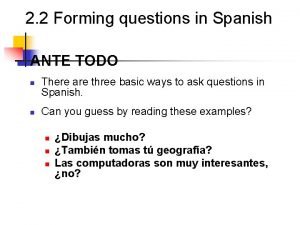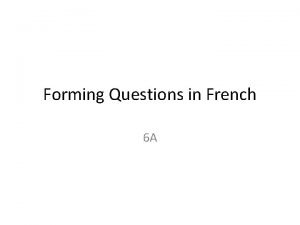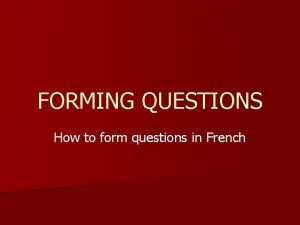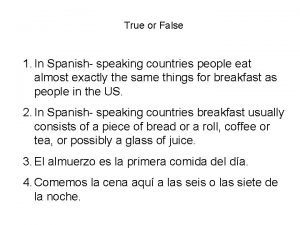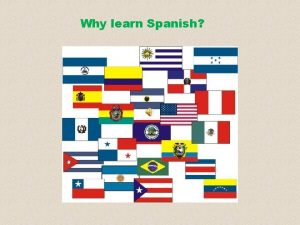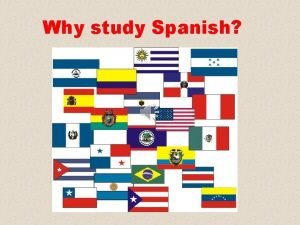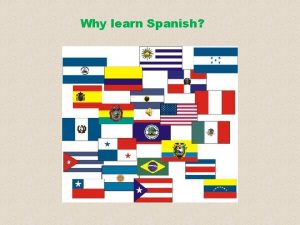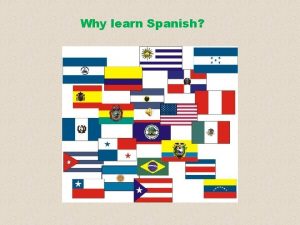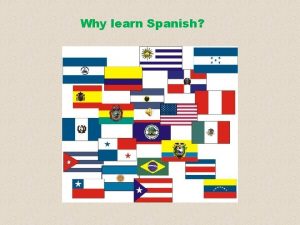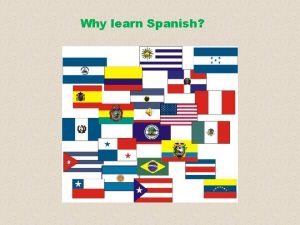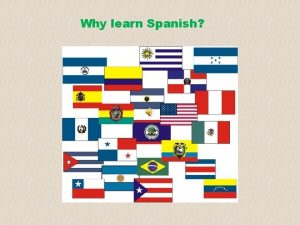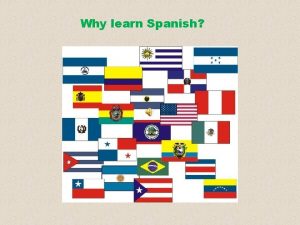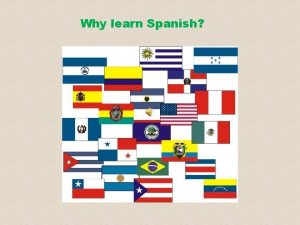Forming Questions in Spanish FORMING QUESTIONS There are











- Slides: 11

Forming Questions in Spanish

FORMING QUESTIONS There are FOUR ways to form questions in Spanish. Note that in English, we form a question using words like “Do, ” “Does, ” “Are, ” etc. In Spanish we use “¿” at the beginning. ¿Hablas español? Do you speak Spanish?

Step 1 Intonation: Raise your voice at the end of a sentence. ¿Ud. es americano? ¿Ud. trabaja en IN-N-Out? ¿Juan vive en México?

Step 2 Add a tag word: By adding the tags ¿no? or ¿verdad? at the end of a statement. Ud. habla inglés, ¿verdad? You speak English, right? Juan vive en México, ¿no? Juan lives in Mexico, doesn’t he? Verdad means (truth), but in a question it means “right? ”

Step 3 Start with a verb: The subject and the verb are switched. Subject may/may not follow, and the subject may be placed at the end of the sentence. (question) ¿Habla Ud. inglés? verb subject (statement) Ud. habla inglés subject verb ¿Canta Juan en la clase? verb subject ¿Habla español Ud. ? verb subject ¿ Estudia mucho? verb Verb first, then subject!!

Practice: Verb first, then the subject! 1. Do you guys Dance? ¿Bailan Uds. ? 2. Does she walk to school? ¿Camina a la escuela ella? 3. ¿Do you sing a lot? ¿Cantas mucho ?

Step 4 Start with a question word: Start with the question word, then switch the verb and the subject. ¿Cómo estudia Ud. ? verb subject How do you study? ¿Dónde trabaja Juan? Where does Juan work? ¿De dónde son Alex y Joe? Where are Alex and Joe from? In Spanish, you cannot put a preposition at the end of a question.

Question Words ¿Por qué? Why? ¿Con quién? With whom? ¿Cuándo? When? ¿Cuál? Which? ¿Qué? What? ¿A qué hora? At what time? ¿Dónde? Where? ¿Adónde? Where (to)? ¿Cuánto/a? How much? ¿De dónde? From where? ¿Cuántos/as? How many? ¿Hay? is/are there? ¿Cómo? How? * All question words have accent ¿Quién? Who? marks on them. Accent marks are place either over the o, e, or a.

Prática Translate to Spanish. Remember the rules when there is a question word! 1. Do you guys work at Burger King? ¿Trabajan en Burger King Uds. ? 2. How does she prepare the dinner? ¿Cómo prepara la cena ella? 3. Do they walk to school? ¿Caminan a la escuela ellos? 4. When do they study? ¿Cuándo estudian ellos?

Prepositions in questions • In Spanish, you may not end a sentence in a preposition, so the question word “where” must have any preposition in front of it, rather than at the end of the sentence. It is quite common to end a question about origin with a preposition in English: “Where is he from? ” for example. The Spanish equivalent of, “Where is he from? ” must be stated, “From where is he? ” ( ¿De dónde es él? ). • The same is true for the preposition a (which means “to”). Sometimes, this preposition is not stated in an English sentence, but any time the question asks where a noun is headed (such as “Where are you going to? ”), the word dónde must have a in front of or attached to it (¿A dónde vas tú? or ¿Adónde vas tú? ).

Prepositions • The personal a is used when the direct or indirect object of a sentence is a word that refers to a person. • ¿A quién tiró la pelota? • To whom did he [she, formal you] throw the ball? • ¿A quién llamaste tú? • Whom did you call? • To indicate the possessor of an item in Spanish, the item is followed by the preposition de and the owner. To request this information, de is followed by the question words quién or quiénes, depending on whether you expect the owner to be one person or more. The English equivalents are “Whose? ” or “Of whom? ”: • ¿De quién es el Pontiac azul en el aparcamiento? • Whose is the blue Pontiac in the parking lot? • ¿De quiénes son esos coches en la esquina?
 Mikael ferm
Mikael ferm Forming questions in spanish
Forming questions in spanish Intentalo statement trabajamos manana
Intentalo statement trabajamos manana Spanish 1 semester 1 final exam answer key
Spanish 1 semester 1 final exam answer key Question in french
Question in french Forming questions in french
Forming questions in french True/false: there are ten spanish-speaking countries.
True/false: there are ten spanish-speaking countries. There is there are ejemplos
There is there are ejemplos There is there are part of speech
There is there are part of speech There is there are negative form
There is there are negative form There is there are
There is there are There aren't any oranges
There aren't any oranges


